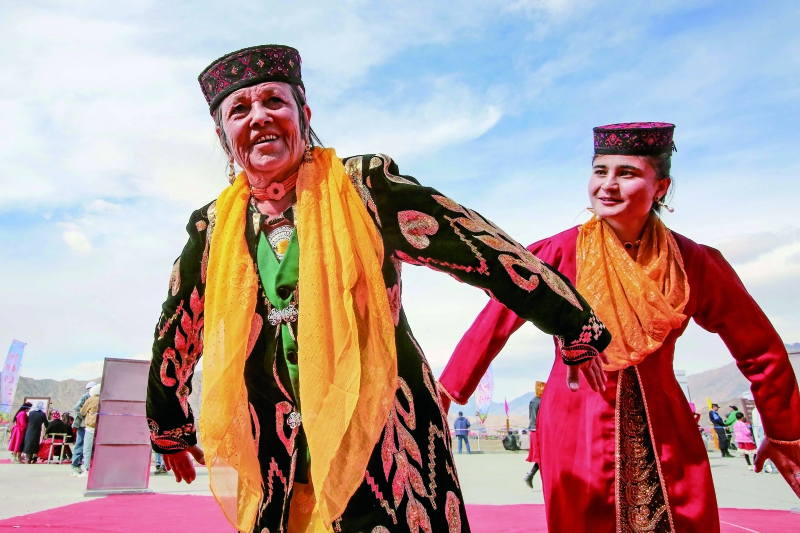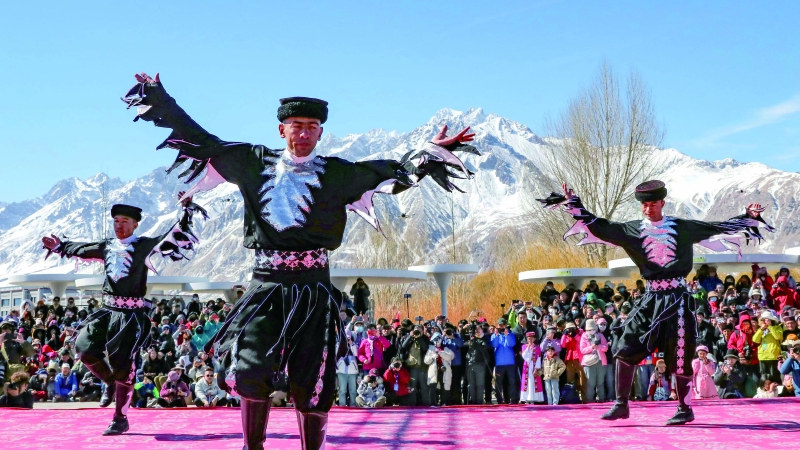The Tajik ethnic group primarily resides in Taxkorgan Tajik Autonomous County, with smaller communities in Pishan, Poskam, and Yarkant counties, which are all situated in northwest China’s Xinjiang. Living in valleys averaging 4,000 meters in altitude, their harsh environment has forged a resilient and optimistic character. For generations, they have herded livestock beneath snow-capped peaks, sharing the skies with eagles—revered as symbols of strength and heroism. Folklore, songs, and even the Eagle Dance itself draw inspiration from the eagle’s grace and power, evolving into the vibrant art form seen today.

Photo taken on March 24, 2025 shows Mayramhan Adili (L), a state-level inheritor of Eagle Dance, presents the dance movements to a learner at the Intangible Cultural Heritage Exhibition Park in Taxkorgan Tajik Autonomous County, Kizilsu Kirgiz Autonomous Prefecture, northwest China’s Xinjiang Uygur Autonomous Region. (Photo by Shiliuyun-Xinjiang Daily/ Cai Zengle)
The Eagle Dance thrives in communal celebrations like weddings and festivals. An organizer waves a red-and-white silk rope, chanting “Shaba Shaba Shaba Hei” (“Go for it!” in Tajik) to rally participants. Older male dancers often take the lead, arms outstretched, inviting others with a bow and a hand over the heart. Guests reciprocate the gesture before joining in. Dancers form circles, mirroring eagles in flight, while newlyweds are encircled like the heart of a blooming flower. The rhythm of Dap, cheers, and whistles fills the air as participants weave clockwise and counterclockwise, their movements echoing the majestic sweep of eagles across the sky.

Photo taken on March 22, 2025 shows performers present the Eagle Dance to tourists at the Caiyun Renjia folk custom village in Taxkorgan Tajik Autonomous County, Kizilsu Kirgiz Autonomous Prefecture, northwest China’s Xinjiang Uygur Autonomous Region. (Photo by Shiliuyun-Xinjiang Daily/ Cai Zengle)
The dance circle pulsed with infectious energy as newcomers swelled the crowd. In a unique tradition, dancers flicked coins skyward from their fingertips, symbolizing blessings of abundance to newlyweds and other dancers. As dancers prepare to leave, they express gratitude with a palms-pressed bow, sealing the exchange of goodwill. For the youth, these gatherings serve as stages where the Eagle Dance's bold moves showcase talent, and eye contact conveys messages and fosters connections.
The dance’s essence lies in its mimicry of eagles. Male dancers contract their abdomens, bend their knees, and swoop their arms as if diving like eagles, their movements bold and forceful. Female dancers glide with fluid elegance, their steps light yet deliberate. Arm positions vary widely, often extended sideways, while footwork ranges from steady stamps to rapid, rhythmic steps. The dance’s intensity ebbs and flows, punctuated by sudden pauses that emphasize its raw, earthy vigor. Some dance steps have a brisk rhythm, strong force, and large undulations. By using the contrast between fast and slow rhythms, they suddenly pause between smooth steps, step on the ground as a rhythm, and are vigorous and powerful. At the same time, it emphasizes the flexibility of the knees, demonstrating a rhythm that combines hardness and softness, and is crisp and smooth.
No exploration of the Eagle Dance is complete without its iconic musical companions — the eagle bone flute and the Tajik Dap. The eagle bone flute, the most emblematic instrument of the Tajik people, is carved from an eagle’s wing bone. Measuring about 25 cm, this hollow, slightly curved flute features three finger holes at the thicker end. Its surface is adorned with intricate carvings, while the tail end sways with colorful tassels made from woolen threads and beads. The flute’s piercing yet crystalline tones carry an unmistakable mountain spirit. When played by folk masters, its voice soars like an eagle riding alpine thermals, shifts to the urgency of spring torrents breaking through ice, then whispers like winds sighing through snow-dusted peaks. Traditionally performed in pairs, two flutists intertwine melodies in a "fish-biting-tail" style — each musician’s phrase catching the last note of the other’s. Tajik Dap is relatively large in size, with a wide drum frame. It is often played by two women in tandem. One anchors the rhythm with primal beats, while the other layers intricate improvisational patterns, their hands dancing across the drumhead like wind-whirled petals. Together, these instruments breathe life into the eagle dance’s storytelling — a dialogue between earth and sky.
Today, the Eagle Dance transcends its role as folk art, becoming a bridge for cultural exchange. Visitors to the Pamir Plateau are captivated by its grace and the flute’s haunting melodies, gaining insight into Tajik traditions. Locals, in turn, share their heritage proudly, fostering cross-cultural understanding.
In 2006, the Tajik Eagle Dance was inscribed in the first batch of state-level intangible heritage items. Recent preservation efforts have revitalized the tradition. Taxkorgan’s cultural tourism initiatives integrate the dance into “Plateau Intangible Heritage” experiences, allowing visitors to experience the making process of eagle flutes, join performances, and immerse themselves in its legacy. As this millennia-old art form continues to evolve, it stands as a testament to the enduring vitality of the Pamir Plateau’s cultural heritage—a dance of eagles, soaring ever higher.
(Source: Xinjiang Art Research Institute, Reporter Tong Fei)
(A written permission shall be obtained for reprinting, excerpting, copying and mirroring of the contents published on this website. Unauthorized aforementioned act shall be deemed an infringement, of which the actor shall be held accountable under the law.)









